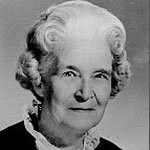S.C. Encyclopedia | Helen von Kolnitz Hyer was born on Dec. 0, 1896, in Charleston, to George von Kolnitz and Sarah Holmes. She attended Simmons College from 1917 to 1918 and married Edward Hyer in 1921. The couple had four daughters. From childhood she had a love of poetry and memorized poems from a book of nineteenth-century English verse, reciting them to visitors at her grandparents’ home in Mount Pleasant. At Ashley Hall in Charleston, one of her poems was selected as the school song. Hyer won youth poetry prizes as well. Her first poem appeared in Romance when she was seventeen; she then was published several times in Adventure Magazine.
Hyer joined the Poetry Society of South Carolina in 1920. Although younger than most group members, she impressed her peers. “What really burnt them up was our first poetry contest,” Hyer recalled. “I won it; they didn’t think a young girl should win.” Her first poetry collection, Santee Songs, was published in 1923. That volume was followed by Wine Dark Sea (1930), The Wimp and the Woodle, and Other Stories (1935), Danger Never Sleeps (1970), and What the Wind Forgets a Woman’s Heart Remembers (1975). During her more than 50 years of writing poetry, Hyer’s work also appeared in magazines such as Poet Lore, Argosy, and the Christian Science Monitor.
In 1974, Hyer became South Carolina’s second poet laureate—a fitting honor for a poet whose work reflected a deep love for her state. Frequent topics of Hyer’s verse include Confederate heroes, South Carolina history, and southern romance. Tennyson and his theme of Camelot was one of her poetic inspirations; Hyer often recreated that magical myth in the familiar world of Carolina’s Lowcountry. Her attention to the outdoor sounds of South Carolina earned recognition as well. The lyrics of her poem “Santee Lullaby” were used by composer Jim Clemens in his choral arrangement “The Tidelands of Georgetown.” Hyer’s words became part of the first movement, “River Lullaby,” premiered by Georgetown’s Indigo Choral Society in 2003.
Hyer’s more serious compositions were balanced with playful poems. In 1968 a limerick of hers won the Poetry Society’s prize: “A lady who lived just to borrow, / Moved next to us, much to our sorrow. / We fulfilled all her wishes, / Now she has all our dishes— / To our sorrow, we’ll borrow, tomorrow.”
Another playful poem, “Portrait of Two Ancient Ladies,” jests: “Her waist is small, her shoes are tight, / She wears black silk and diamond broaches, / Her parlor’s full of Hepplewhite / Her kitchen’s full of roaches.”
Hyer cared about spreading a love of poetry in South Carolina, particularly among the state’s young people. She fulfilled her role of poet laureate well, traveling and giving poetry readings, allowing many to hear the musical rhythms of her verse firsthand. She died in Beaufort on November 14, 1983, and was buried in Charleston’s Magnolia Cemetery.
— Excerpted from an entry by Amy L. White. This entry hasn’t been updated since 2006. To read more about this or 2,000 other entries about South Carolina, check out The South Carolina Encyclopedia, published in 2006 by USC Press. (Information used by permission.)




 We Can Do Better, South Carolina!
We Can Do Better, South Carolina!
























